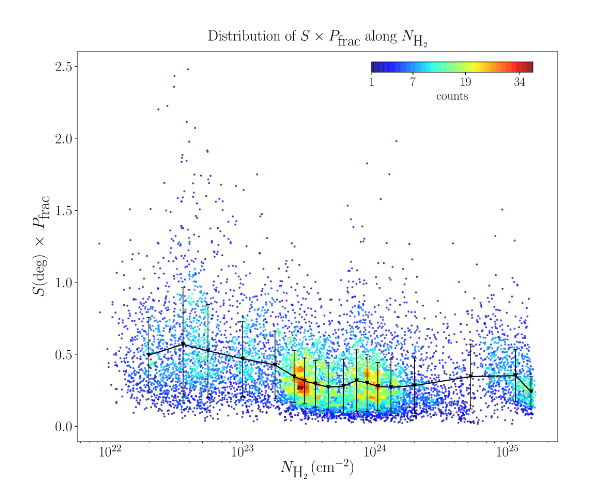A statistical analysis of dust polarization properties in ALMA observations of Class 0 protostellar cores
Le Gouellec V. J. M., Maury A. J., Guillet V., Hull C. L. H., Girart J. M., Verliat A., Mignon-Risse R., Valdivia V., Hennebelle P., González M., Louvet F.
Published in A&A, DECEMBER 2020Recent observational progress has challenged the dust grain-alignment theories used to explain the polarized dust emission routinely observed in star-forming cores. Aims: In an effort to improve our understanding of the dust grain alignment mechanism(s), we have gathered a dozen ALMA maps of (sub)millimeter-wavelength polarized dust emission from Class 0 protostars and carried out a comprehensive statistical analysis of dust polarization quantities. We analyze the statistical properties of the polarization fraction Pfrac and the dispersion of polarization position angles S. More specifically, we investigate the relationship between S and Pfrac as well as the evolution of the product S × Pfrac as a function of the column density of the gas in the protostellar envelopes. We compare the observed trends with those found in polarization observations of dust in the interstellar medium and in synthetic observations of non-ideal magneto-hydrodynamic (MHD) simulations of protostellar cores. We find a significant S ∝ Pfrac^-0.79 correlation in the polarized dust emission from protostellar envelopes seen with ALMA; the power-law index significantly differs from the one observed by Planck in star-forming clouds. The product S × Pfrac, which is sensitive to the dust grain alignment efficiency, is approximately constant across three orders of magnitude in envelope column density (from N(H2) = 10^22 cm-2 to NH2 = 10^25 cm-2), with a mean value of 0.36. This suggests that the grain alignment mechanism producing the bulk of the polarized dust emission in star-forming cores may not systematically depend on the local conditions such as the local gas density. However, in the lowest-luminosity sources in our sample, we find a hint of less efficient dust grain alignment with increasing column density. Our observations and their comparison with synthetic observations of MHD models suggest that the total intensity versus the polarized dust are distributed at different intrinsic spatial scales, which can affect the statistics from the ALMA observations, for example, by producing artificially high Pfrac. Finally, synthetic observations of MHD models implementing radiative alignment torques (RATs) show that the statistical estimator S × Pfrac is sensitive to the strength of the radiation field in the core. Moreover, we find that the simulations with a uniform perfect alignment (PA) of dust grains yield, on average, much higher S × Pfrac values than those implementing RATs; the ALMA values lie among those predicted by PA, and they are significantly higher than the ones obtained with RATs, especially at large column densities. Ultimately, our results suggest that dust alignment mechanism(s) are efficient at producing dust polarized emission in the various local conditions typical of Class 0 protostars. The grain alignment efficiency found in these objects seems to be higher than the efficiency produced by the standard RAT alignment of paramagnetic grains. Further studies will be needed to understand how more efficient grain alignment via, for example, different irradiation conditions, dust grain characteristics, or additional grain alignment mechanisms can reproduce the observations.
